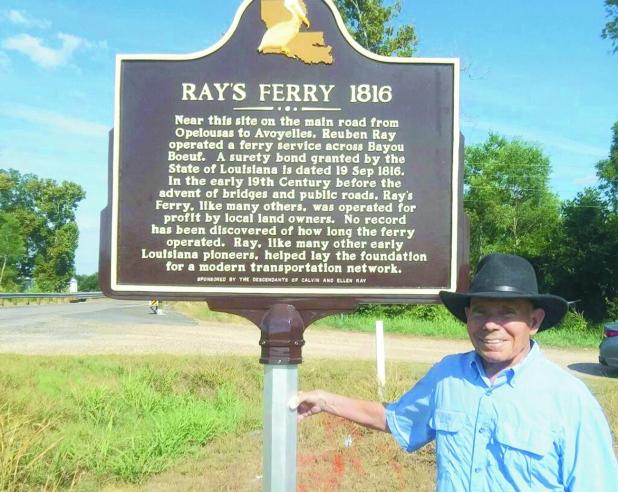
Dale Ray stands at the historical marker commemorating Ray’s Ferry-1816. The ferry was owned by his great-great-great-grandfather Reuben Ray.
Ray’s Ferry over Bayou Boeuf, once lost to history, finds new life
The essence of history is that as years roll on some things get rolled over. Such is the case of Ray’s Ferry, which was just out of Bunkie. Once an important cog in the road from Opelousas to Avoyelles in the early 1800s, the ferry owned by Reuben Ray gave travelers a way to cross Bayou Boeuf.
Currently a very nondescript bridge on Hwy 115 stands in the area of the famous point and as cars speed by they are completely unaware.
Thanks to the determined effort of Dale Ray, the great-great-great-grandson of Reuben, a bronze plaque has been erected not just to mark the spot but to honor the Ray family ancestor.
According to Dale, Reuben received a land grant of 640 acres along Bayou Boeuf after the Louisiana Purchase. Here he grew cotton and corn.
The closest settlement was Cheneyville; the railroad that Bunkie grew up around was not even established yet.
Dale added a very interesting footnote. “James Bowie was a close neighbor to Reuben, between 1814 and 1816. Bowie survived by cutting timber and barging it down the bayou to New Orleans.”
Reuben married and had four children. In 1816 he decided to add to his income by starting a ferry service on the bayou.
“Water levels fluctuated a great deal so at times fording on horseback, on foot or wagon must have been difficult,” Dale commented “Reuben applied to the state and paid a surety bond of $100 for his ferry permit.”
The ferry was important because the main road from Opelousas to Avoyelles served as a connection between North and South Louisiana.
Dale continued, “Bridge crossings were not only very expensive to build and maintain but obstacles to waterborne commerce.”
Property owners living adjacent to the few main roads were often enlisted to provide a means to cross bayous that were close by. As it turned out, the ferry crossings or landings became important links in the developing road work.
All the history Dale has accumulated ended in the erection of the plaque on Thursday, Aug. 3 by the bridge on Hwy. 115.
It was a long ordeal but Dale hung in. There are only a certain number of Louisiana historical markers allowed a year and if the deadline is missed, you have to wait until the following year.
“I had to complete an application, submit supportive materials and a bibliography,” he explained.
Dale attributes a kernel of information about Ray’s Ferry to a friend who has since passed and who was dabbling in genealogy.
That tidbit was enough to send him to Opelousas and the courthouse to find the surety bond where it was filed over 200 years ago.
With that effort under his belt, Dale could say with complete assurance, “The Clerk’s office in Avoyelles is very well organized. They have made copies of documents 250 years old and bound them. It is so much easier to do research there.”
The plaque had to be approved by the History Department at LSU as well as the La. Dept. of Tourism.
“The Tourism office actually came to the site and determined the area,” Dale said. “It was the La. Dept. of Transportation who put the sign in the ground.”
Now that the plaque, in English and French by the way, is up Dale said, “It is important to our family, important to us to recognize our ancestor.”
